Recording Business Transactions Assignment 1, BA30592E, UWLC
VerifiedAdded on 2022/02/10
|18
|5146
|16
Homework Assignment
AI Summary
This document is a comprehensive study guide and solution for BA30592E Assignment 1, focusing on recording business transactions. The assignment covers key aspects of accounting including providing steps for starting a new business, identifying decision makers, and preparing journal entries for various transactions. It includes T-accounts, trial balances, and income statements. The assignment also requires analyzing financial data and predicting profit/loss trends. The document offers detailed solutions to all parts of the assignment, ensuring a thorough understanding of the concepts and practical application of accounting principles. It covers double-entry bookkeeping, the accounting equation, and financial statement analysis to help students master the fundamentals of financial accounting and prepare for future assessments.
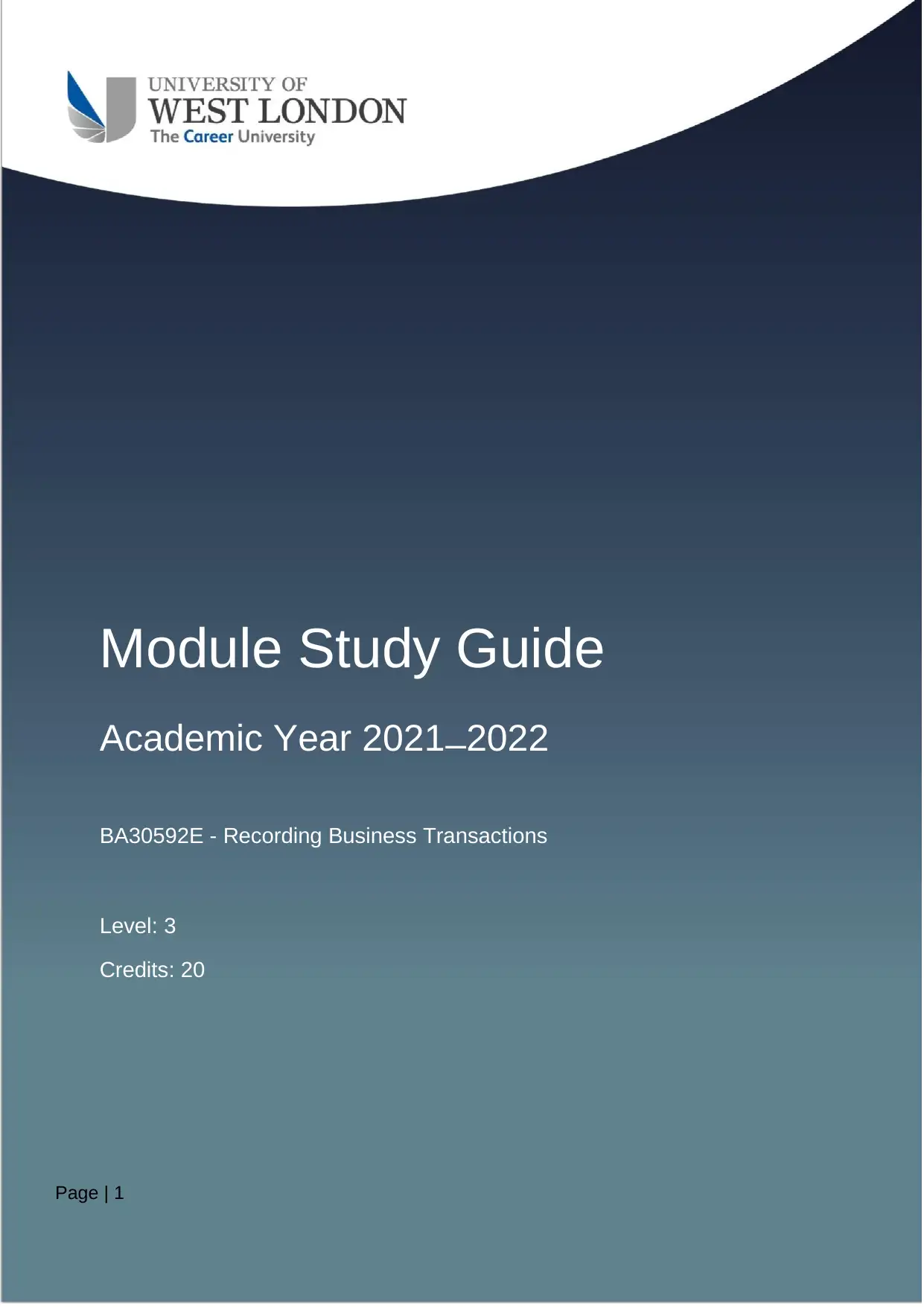
Module Study Guide
Academic Year 2021–2022
BA30592E - Recording Business Transactions
Level: 3
Credits: 20
Page | 1
Academic Year 2021–2022
BA30592E - Recording Business Transactions
Level: 3
Credits: 20
Page | 1
Paraphrase This Document
Need a fresh take? Get an instant paraphrase of this document with our AI Paraphraser
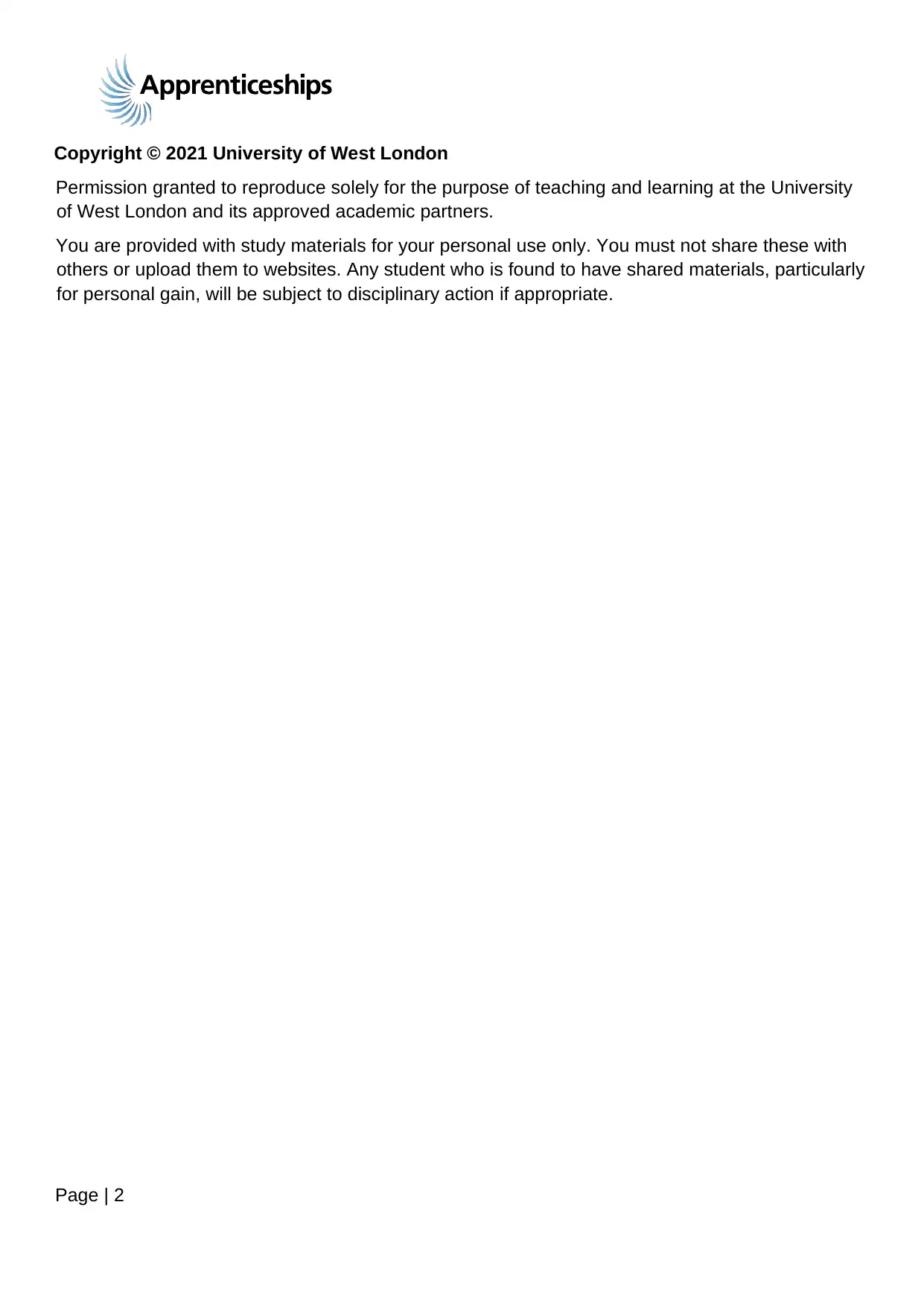
Page | 2
Copyright © 2021 University of West London
Permission granted to reproduce solely for the purpose of teaching and learning at the University
of West London and its approved academic partners.
You are provided with study materials for your personal use only. You must not share these with
others or upload them to websites. Any student who is found to have shared materials, particularly
for personal gain, will be subject to disciplinary action if appropriate.
Copyright © 2021 University of West London
Permission granted to reproduce solely for the purpose of teaching and learning at the University
of West London and its approved academic partners.
You are provided with study materials for your personal use only. You must not share these with
others or upload them to websites. Any student who is found to have shared materials, particularly
for personal gain, will be subject to disciplinary action if appropriate.
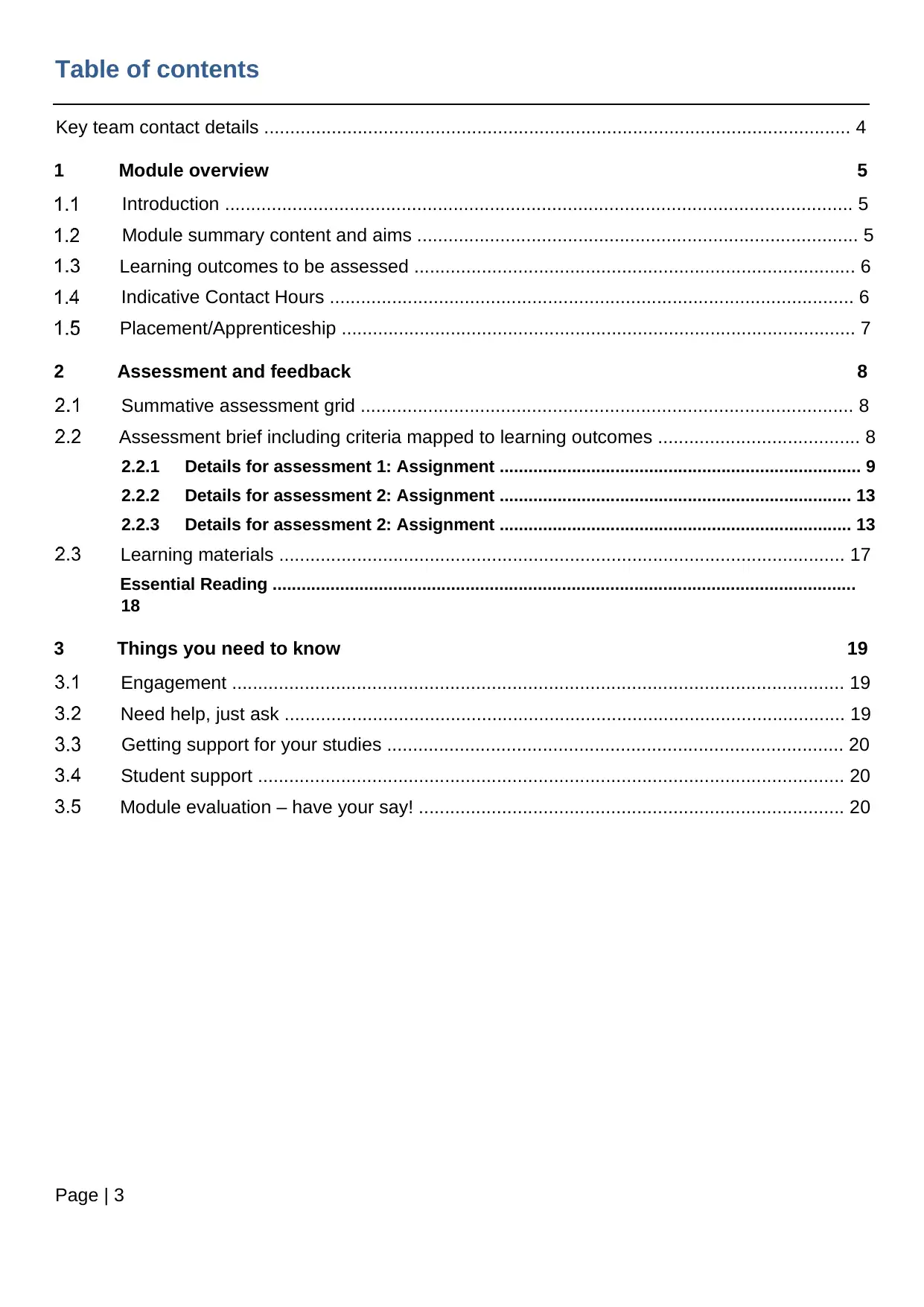
Page | 3
Table of contents
Key team contact details ................................................................................................................. 4
1 Module overview 5
Introduction ......................................................................................................................... 5
Module summary content and aims ..................................................................................... 5
Learning outcomes to be assessed ..................................................................................... 6
Indicative Contact Hours ..................................................................................................... 6
Placement/Apprenticeship ................................................................................................... 7
2 Assessment and feedback 8
Summative assessment grid ............................................................................................... 8
Assessment brief including criteria mapped to learning outcomes ....................................... 8
2.2.1 Details for assessment 1: Assignment ........................................................................... 9
2.2.2 Details for assessment 2: Assignment ......................................................................... 13
2.2.3 Details for assessment 2: Assignment ......................................................................... 13
Learning materials ............................................................................................................. 17
Essential Reading .........................................................................................................................
18
3 Things you need to know 19
Engagement ...................................................................................................................... 19
Need help, just ask ............................................................................................................ 19
Getting support for your studies ........................................................................................ 20
Student support ................................................................................................................. 20
Module evaluation – have your say! .................................................................................. 20
Table of contents
Key team contact details ................................................................................................................. 4
1 Module overview 5
Introduction ......................................................................................................................... 5
Module summary content and aims ..................................................................................... 5
Learning outcomes to be assessed ..................................................................................... 6
Indicative Contact Hours ..................................................................................................... 6
Placement/Apprenticeship ................................................................................................... 7
2 Assessment and feedback 8
Summative assessment grid ............................................................................................... 8
Assessment brief including criteria mapped to learning outcomes ....................................... 8
2.2.1 Details for assessment 1: Assignment ........................................................................... 9
2.2.2 Details for assessment 2: Assignment ......................................................................... 13
2.2.3 Details for assessment 2: Assignment ......................................................................... 13
Learning materials ............................................................................................................. 17
Essential Reading .........................................................................................................................
18
3 Things you need to know 19
Engagement ...................................................................................................................... 19
Need help, just ask ............................................................................................................ 19
Getting support for your studies ........................................................................................ 20
Student support ................................................................................................................. 20
Module evaluation – have your say! .................................................................................. 20
⊘ This is a preview!⊘
Do you want full access?
Subscribe today to unlock all pages.

Trusted by 1+ million students worldwide
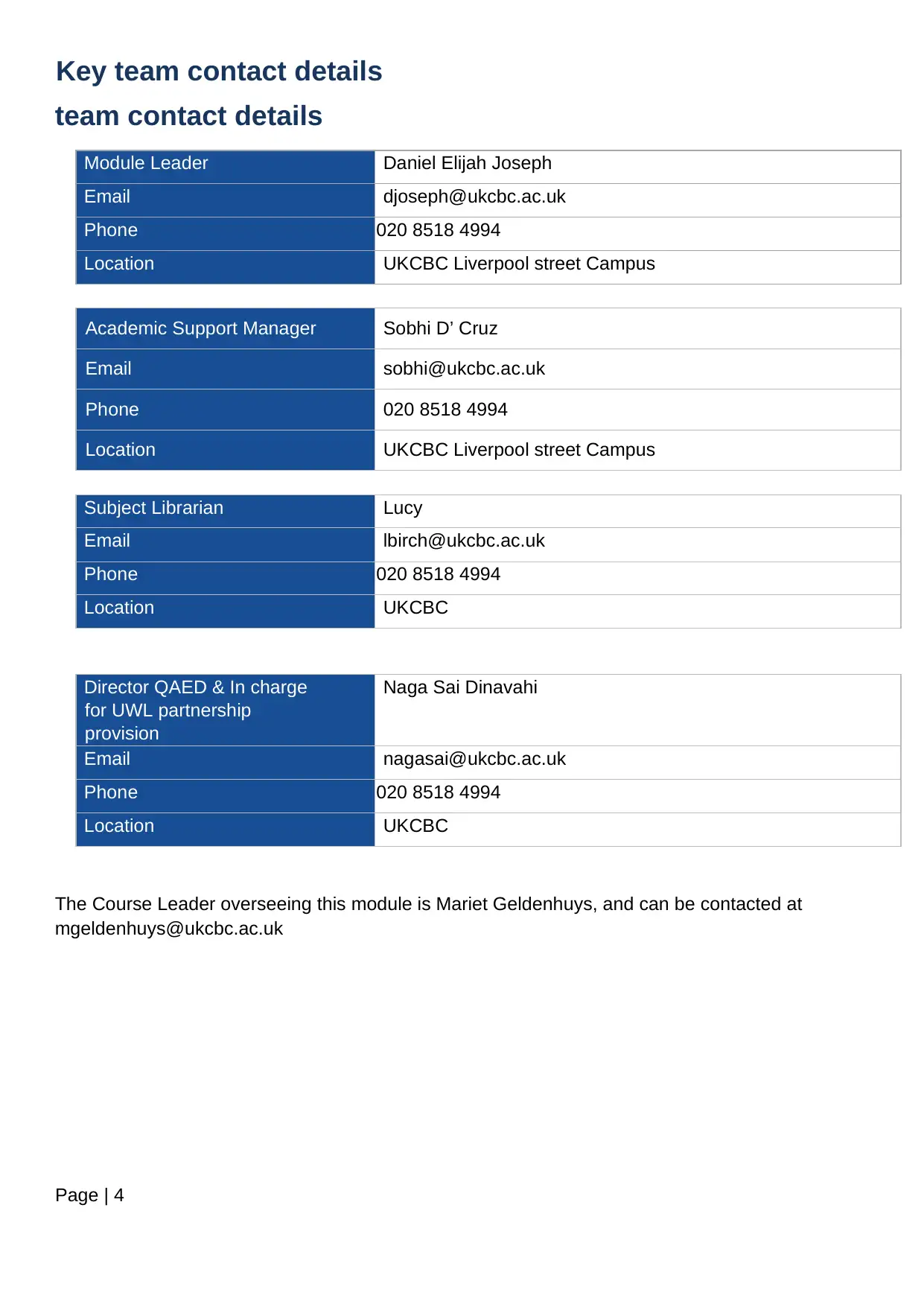
Page | 4
Key team contact details
team contact details
Module Leader Daniel Elijah Joseph
Email djoseph@ukcbc.ac.uk
Phone 020 8518 4994
Location UKCBC Liverpool street Campus
Academic Support Manager Sobhi D’ Cruz
Email sobhi@ukcbc.ac.uk
Phone 020 8518 4994
Location UKCBC Liverpool street Campus
Subject Librarian Lucy
Email lbirch@ukcbc.ac.uk
Phone 020 8518 4994
Location UKCBC
Director QAED & In charge
for UWL partnership
provision
Naga Sai Dinavahi
Email nagasai@ukcbc.ac.uk
Phone 020 8518 4994
Location UKCBC
The Course Leader overseeing this module is Mariet Geldenhuys, and can be contacted at
mgeldenhuys@ukcbc.ac.uk
Key team contact details
team contact details
Module Leader Daniel Elijah Joseph
Email djoseph@ukcbc.ac.uk
Phone 020 8518 4994
Location UKCBC Liverpool street Campus
Academic Support Manager Sobhi D’ Cruz
Email sobhi@ukcbc.ac.uk
Phone 020 8518 4994
Location UKCBC Liverpool street Campus
Subject Librarian Lucy
Email lbirch@ukcbc.ac.uk
Phone 020 8518 4994
Location UKCBC
Director QAED & In charge
for UWL partnership
provision
Naga Sai Dinavahi
Email nagasai@ukcbc.ac.uk
Phone 020 8518 4994
Location UKCBC
The Course Leader overseeing this module is Mariet Geldenhuys, and can be contacted at
mgeldenhuys@ukcbc.ac.uk
Paraphrase This Document
Need a fresh take? Get an instant paraphrase of this document with our AI Paraphraser
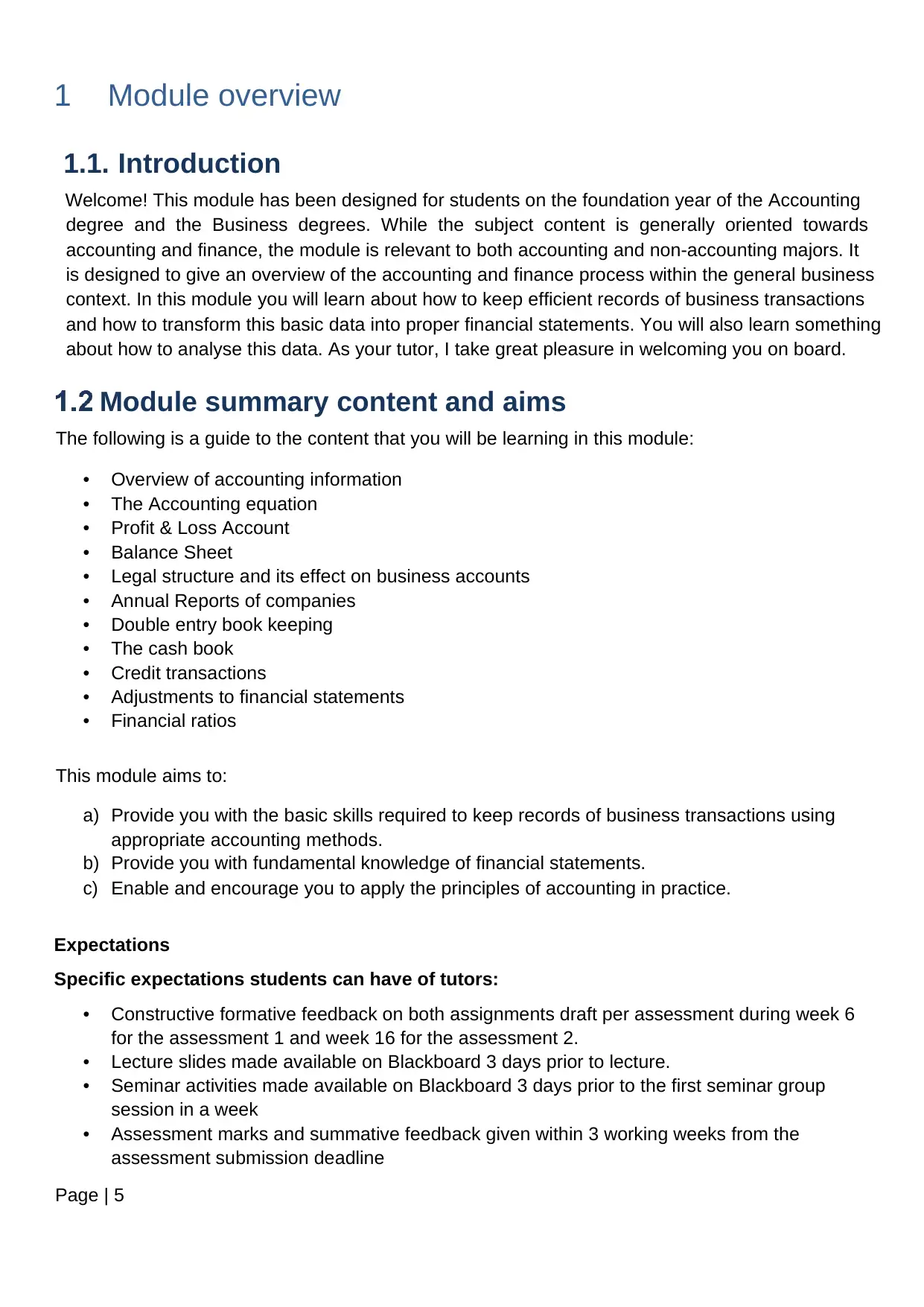
Page | 5
1 Module overview
1.1. Introduction
Welcome! This module has been designed for students on the foundation year of the Accounting
degree and the Business degrees. While the subject content is generally oriented towards
accounting and finance, the module is relevant to both accounting and non-accounting majors. It
is designed to give an overview of the accounting and finance process within the general business
context. In this module you will learn about how to keep efficient records of business transactions
and how to transform this basic data into proper financial statements. You will also learn something
about how to analyse this data. As your tutor, I take great pleasure in welcoming you on board.
Module summary content and aims
The following is a guide to the content that you will be learning in this module:
• Overview of accounting information
• The Accounting equation
• Profit & Loss Account
• Balance Sheet
• Legal structure and its effect on business accounts
• Annual Reports of companies
• Double entry book keeping
• The cash book
• Credit transactions
• Adjustments to financial statements
• Financial ratios
This module aims to:
a) Provide you with the basic skills required to keep records of business transactions using
appropriate accounting methods.
b) Provide you with fundamental knowledge of financial statements.
c) Enable and encourage you to apply the principles of accounting in practice.
Expectations
Specific expectations students can have of tutors:
• Constructive formative feedback on both assignments draft per assessment during week 6
for the assessment 1 and week 16 for the assessment 2.
• Lecture slides made available on Blackboard 3 days prior to lecture.
• Seminar activities made available on Blackboard 3 days prior to the first seminar group
session in a week
• Assessment marks and summative feedback given within 3 working weeks from the
assessment submission deadline
1 Module overview
1.1. Introduction
Welcome! This module has been designed for students on the foundation year of the Accounting
degree and the Business degrees. While the subject content is generally oriented towards
accounting and finance, the module is relevant to both accounting and non-accounting majors. It
is designed to give an overview of the accounting and finance process within the general business
context. In this module you will learn about how to keep efficient records of business transactions
and how to transform this basic data into proper financial statements. You will also learn something
about how to analyse this data. As your tutor, I take great pleasure in welcoming you on board.
Module summary content and aims
The following is a guide to the content that you will be learning in this module:
• Overview of accounting information
• The Accounting equation
• Profit & Loss Account
• Balance Sheet
• Legal structure and its effect on business accounts
• Annual Reports of companies
• Double entry book keeping
• The cash book
• Credit transactions
• Adjustments to financial statements
• Financial ratios
This module aims to:
a) Provide you with the basic skills required to keep records of business transactions using
appropriate accounting methods.
b) Provide you with fundamental knowledge of financial statements.
c) Enable and encourage you to apply the principles of accounting in practice.
Expectations
Specific expectations students can have of tutors:
• Constructive formative feedback on both assignments draft per assessment during week 6
for the assessment 1 and week 16 for the assessment 2.
• Lecture slides made available on Blackboard 3 days prior to lecture.
• Seminar activities made available on Blackboard 3 days prior to the first seminar group
session in a week
• Assessment marks and summative feedback given within 3 working weeks from the
assessment submission deadline
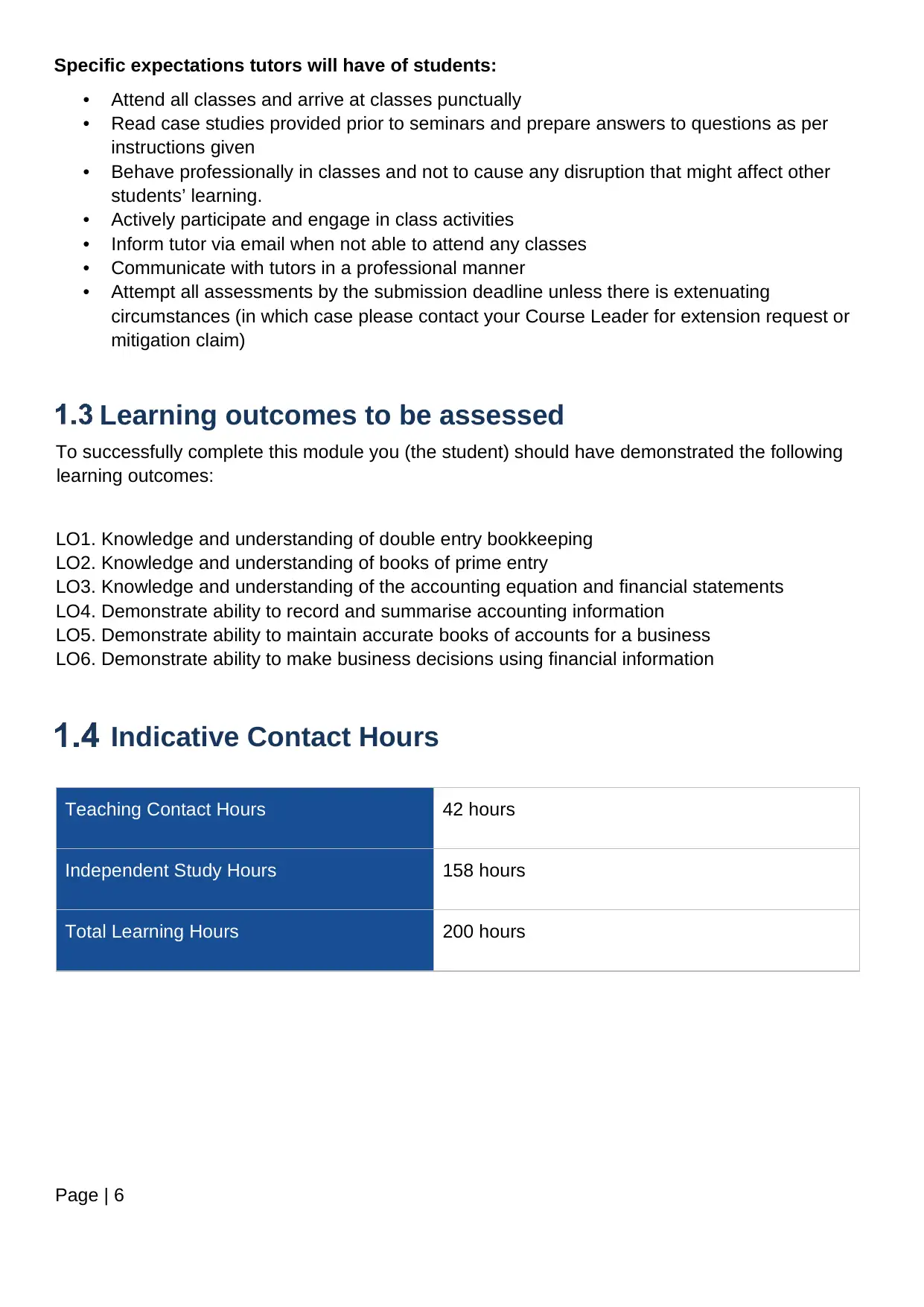
Page | 6
Specific expectations tutors will have of students:
• Attend all classes and arrive at classes punctually
• Read case studies provided prior to seminars and prepare answers to questions as per
instructions given
• Behave professionally in classes and not to cause any disruption that might affect other
students’ learning.
• Actively participate and engage in class activities
• Inform tutor via email when not able to attend any classes
• Communicate with tutors in a professional manner
• Attempt all assessments by the submission deadline unless there is extenuating
circumstances (in which case please contact your Course Leader for extension request or
mitigation claim)
Learning outcomes to be assessed
To successfully complete this module you (the student) should have demonstrated the following
learning outcomes:
LO1. Knowledge and understanding of double entry bookkeeping
LO2. Knowledge and understanding of books of prime entry
LO3. Knowledge and understanding of the accounting equation and financial statements
LO4. Demonstrate ability to record and summarise accounting information
LO5. Demonstrate ability to maintain accurate books of accounts for a business
LO6. Demonstrate ability to make business decisions using financial information
Indicative Contact Hours
Teaching Contact Hours 42 hours
Independent Study Hours 158 hours
Total Learning Hours 200 hours
Specific expectations tutors will have of students:
• Attend all classes and arrive at classes punctually
• Read case studies provided prior to seminars and prepare answers to questions as per
instructions given
• Behave professionally in classes and not to cause any disruption that might affect other
students’ learning.
• Actively participate and engage in class activities
• Inform tutor via email when not able to attend any classes
• Communicate with tutors in a professional manner
• Attempt all assessments by the submission deadline unless there is extenuating
circumstances (in which case please contact your Course Leader for extension request or
mitigation claim)
Learning outcomes to be assessed
To successfully complete this module you (the student) should have demonstrated the following
learning outcomes:
LO1. Knowledge and understanding of double entry bookkeeping
LO2. Knowledge and understanding of books of prime entry
LO3. Knowledge and understanding of the accounting equation and financial statements
LO4. Demonstrate ability to record and summarise accounting information
LO5. Demonstrate ability to maintain accurate books of accounts for a business
LO6. Demonstrate ability to make business decisions using financial information
Indicative Contact Hours
Teaching Contact Hours 42 hours
Independent Study Hours 158 hours
Total Learning Hours 200 hours
⊘ This is a preview!⊘
Do you want full access?
Subscribe today to unlock all pages.

Trusted by 1+ million students worldwide
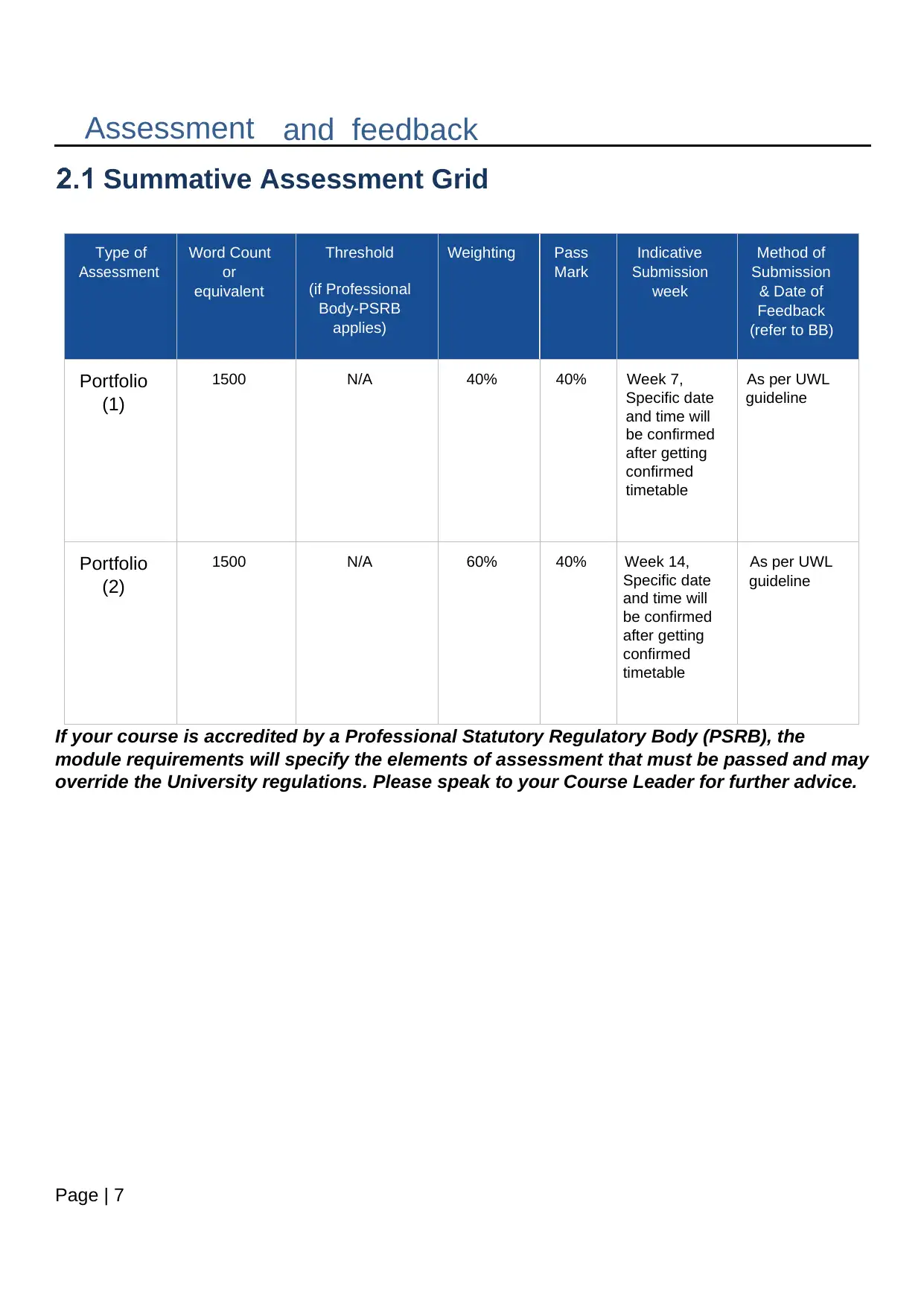
Page | 7
Assessment and feedback
Summative Assessment Grid
Type of
Assessment
Word Count
or
equivalent
Threshold
(if Professional
Body-PSRB
applies)
Weighting Pass
Mark
Indicative
Submission
week
Method of
Submission
& Date of
Feedback
(refer to BB)
Portfolio
(1)
1500 N/A 40% 40% Week 7,
Specific date
and time will
be confirmed
after getting
confirmed
timetable
As per UWL
guideline
Portfolio
(2)
1500 N/A 60% 40% Week 14,
Specific date
and time will
be confirmed
after getting
confirmed
timetable
As per UWL
guideline
If your course is accredited by a Professional Statutory Regulatory Body (PSRB), the
module requirements will specify the elements of assessment that must be passed and may
override the University regulations. Please speak to your Course Leader for further advice.
Assessment and feedback
Summative Assessment Grid
Type of
Assessment
Word Count
or
equivalent
Threshold
(if Professional
Body-PSRB
applies)
Weighting Pass
Mark
Indicative
Submission
week
Method of
Submission
& Date of
Feedback
(refer to BB)
Portfolio
(1)
1500 N/A 40% 40% Week 7,
Specific date
and time will
be confirmed
after getting
confirmed
timetable
As per UWL
guideline
Portfolio
(2)
1500 N/A 60% 40% Week 14,
Specific date
and time will
be confirmed
after getting
confirmed
timetable
As per UWL
guideline
If your course is accredited by a Professional Statutory Regulatory Body (PSRB), the
module requirements will specify the elements of assessment that must be passed and may
override the University regulations. Please speak to your Course Leader for further advice.
Paraphrase This Document
Need a fresh take? Get an instant paraphrase of this document with our AI Paraphraser
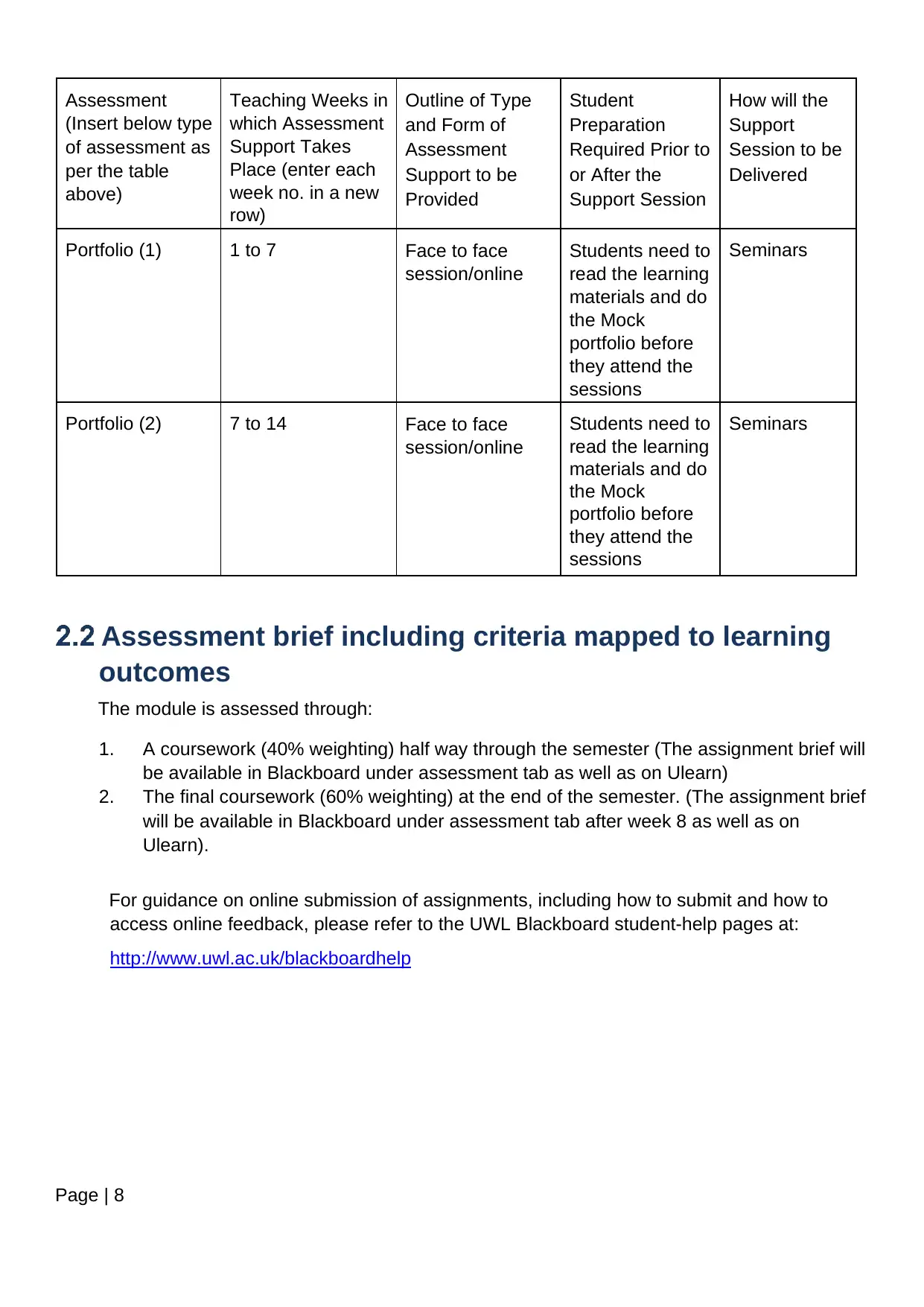
Page | 8
Assessment
(Insert below type
of assessment as
per the table
above)
Teaching Weeks in
which Assessment
Support Takes
Place (enter each
week no. in a new
row)
Outline of Type
and Form of
Assessment
Support to be
Provided
Student
Preparation
Required Prior to
or After the
Support Session
How will the
Support
Session to be
Delivered
Portfolio (1) 1 to 7 Face to face
session/online
Students need to
read the learning
materials and do
the Mock
portfolio before
they attend the
sessions
Seminars
Portfolio (2) 7 to 14 Face to face
session/online
Students need to
read the learning
materials and do
the Mock
portfolio before
they attend the
sessions
Seminars
Assessment brief including criteria mapped to learning
outcomes
The module is assessed through:
1. A coursework (40% weighting) half way through the semester (The assignment brief will
be available in Blackboard under assessment tab as well as on Ulearn)
2. The final coursework (60% weighting) at the end of the semester. (The assignment brief
will be available in Blackboard under assessment tab after week 8 as well as on
Ulearn).
For guidance on online submission of assignments, including how to submit and how to
access online feedback, please refer to the UWL Blackboard student-help pages at:
http://www.uwl.ac.uk/blackboardhelp
Assessment
(Insert below type
of assessment as
per the table
above)
Teaching Weeks in
which Assessment
Support Takes
Place (enter each
week no. in a new
row)
Outline of Type
and Form of
Assessment
Support to be
Provided
Student
Preparation
Required Prior to
or After the
Support Session
How will the
Support
Session to be
Delivered
Portfolio (1) 1 to 7 Face to face
session/online
Students need to
read the learning
materials and do
the Mock
portfolio before
they attend the
sessions
Seminars
Portfolio (2) 7 to 14 Face to face
session/online
Students need to
read the learning
materials and do
the Mock
portfolio before
they attend the
sessions
Seminars
Assessment brief including criteria mapped to learning
outcomes
The module is assessed through:
1. A coursework (40% weighting) half way through the semester (The assignment brief will
be available in Blackboard under assessment tab as well as on Ulearn)
2. The final coursework (60% weighting) at the end of the semester. (The assignment brief
will be available in Blackboard under assessment tab after week 8 as well as on
Ulearn).
For guidance on online submission of assignments, including how to submit and how to
access online feedback, please refer to the UWL Blackboard student-help pages at:
http://www.uwl.ac.uk/blackboardhelp
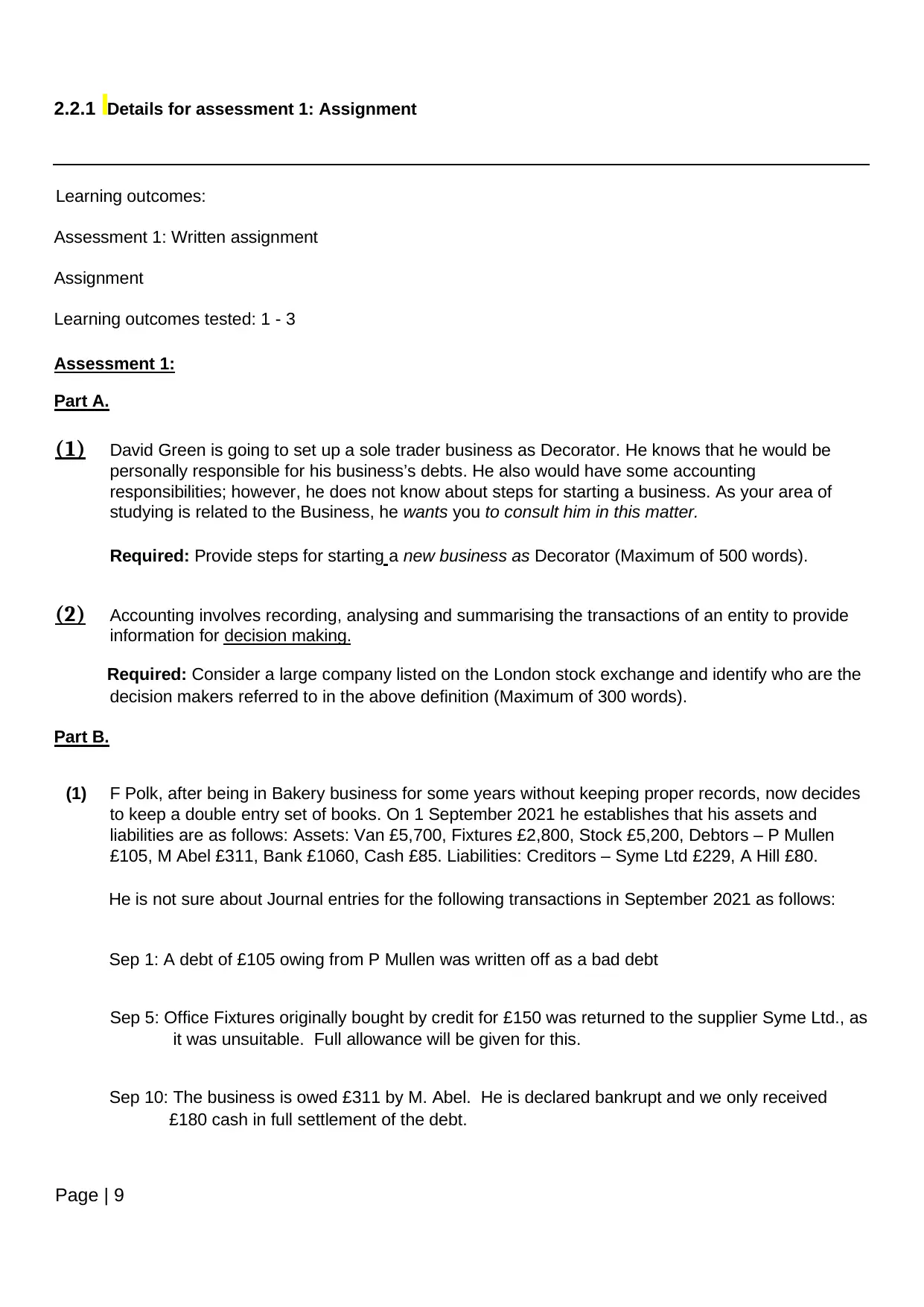
Page | 9
2.2.1 Details for assessment 1: Assignment
Learning outcomes:
Assessment 1: Written assignment
Assignment
Learning outcomes tested: 1 - 3
Assessment 1:
Part A.
(1) David Green is going to set up a sole trader business as Decorator. He knows that he would be
personally responsible for his business’s debts. He also would have some accounting
responsibilities; however, he does not know about steps for starting a business. As your area of
studying is related to the Business, he wants you to consult him in this matter.
Required: Provide steps for starting a new business as Decorator (Maximum of 500 words).
(2) Accounting involves recording, analysing and summarising the transactions of an entity to provide
information for decision making.
Required: Consider a large company listed on the London stock exchange and identify who are the
decision makers referred to in the above definition (Maximum of 300 words).
Part B.
(1) F Polk, after being in Bakery business for some years without keeping proper records, now decides
to keep a double entry set of books. On 1 September 2021 he establishes that his assets and
liabilities are as follows: Assets: Van £5,700, Fixtures £2,800, Stock £5,200, Debtors – P Mullen
£105, M Abel £311, Bank £1060, Cash £85. Liabilities: Creditors – Syme Ltd £229, A Hill £80.
He is not sure about Journal entries for the following transactions in September 2021 as follows:
Sep 1: A debt of £105 owing from P Mullen was written off as a bad debt
Sep 5: Office Fixtures originally bought by credit for £150 was returned to the supplier Syme Ltd., as
it was unsuitable. Full allowance will be given for this.
Sep 10: The business is owed £311 by M. Abel. He is declared bankrupt and we only received
£180 cash in full settlement of the debt.
2.2.1 Details for assessment 1: Assignment
Learning outcomes:
Assessment 1: Written assignment
Assignment
Learning outcomes tested: 1 - 3
Assessment 1:
Part A.
(1) David Green is going to set up a sole trader business as Decorator. He knows that he would be
personally responsible for his business’s debts. He also would have some accounting
responsibilities; however, he does not know about steps for starting a business. As your area of
studying is related to the Business, he wants you to consult him in this matter.
Required: Provide steps for starting a new business as Decorator (Maximum of 500 words).
(2) Accounting involves recording, analysing and summarising the transactions of an entity to provide
information for decision making.
Required: Consider a large company listed on the London stock exchange and identify who are the
decision makers referred to in the above definition (Maximum of 300 words).
Part B.
(1) F Polk, after being in Bakery business for some years without keeping proper records, now decides
to keep a double entry set of books. On 1 September 2021 he establishes that his assets and
liabilities are as follows: Assets: Van £5,700, Fixtures £2,800, Stock £5,200, Debtors – P Mullen
£105, M Abel £311, Bank £1060, Cash £85. Liabilities: Creditors – Syme Ltd £229, A Hill £80.
He is not sure about Journal entries for the following transactions in September 2021 as follows:
Sep 1: A debt of £105 owing from P Mullen was written off as a bad debt
Sep 5: Office Fixtures originally bought by credit for £150 was returned to the supplier Syme Ltd., as
it was unsuitable. Full allowance will be given for this.
Sep 10: The business is owed £311 by M. Abel. He is declared bankrupt and we only received
£180 cash in full settlement of the debt.
⊘ This is a preview!⊘
Do you want full access?
Subscribe today to unlock all pages.

Trusted by 1+ million students worldwide
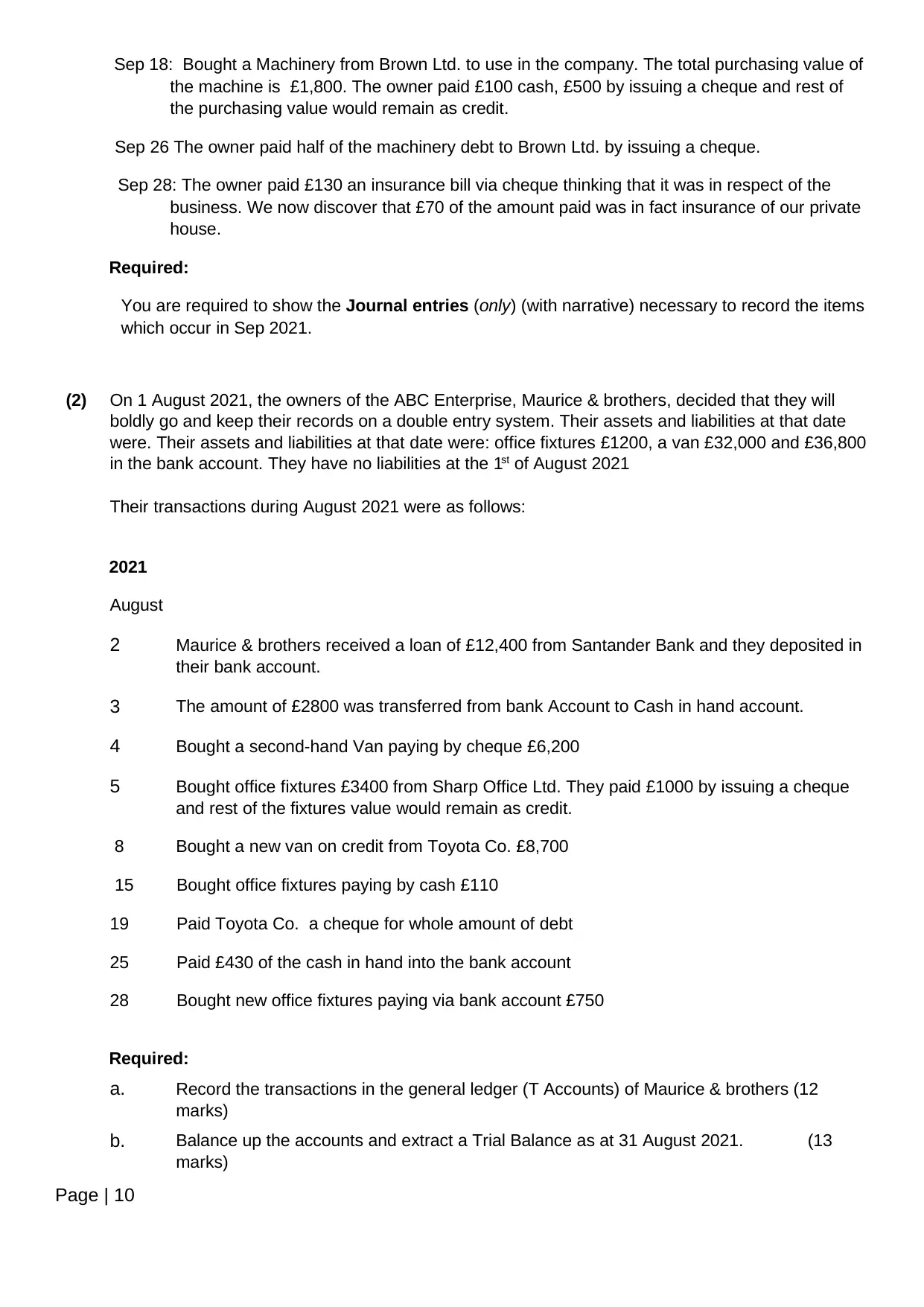
Page | 10
Sep 18: Bought a Machinery from Brown Ltd. to use in the company. The total purchasing value of
the machine is £1,800. The owner paid £100 cash, £500 by issuing a cheque and rest of
the purchasing value would remain as credit.
Sep 26 The owner paid half of the machinery debt to Brown Ltd. by issuing a cheque.
Sep 28: The owner paid £130 an insurance bill via cheque thinking that it was in respect of the
business. We now discover that £70 of the amount paid was in fact insurance of our private
house.
Required:
You are required to show the Journal entries (only) (with narrative) necessary to record the items
which occur in Sep 2021.
(2) On 1 August 2021, the owners of the ABC Enterprise, Maurice & brothers, decided that they will
boldly go and keep their records on a double entry system. Their assets and liabilities at that date
were. Their assets and liabilities at that date were: office fixtures £1200, a van £32,000 and £36,800
in the bank account. They have no liabilities at the 1st of August 2021
Their transactions during August 2021 were as follows:
2021
August
2 Maurice & brothers received a loan of £12,400 from Santander Bank and they deposited in
their bank account.
3 The amount of £2800 was transferred from bank Account to Cash in hand account.
4 Bought a second-hand Van paying by cheque £6,200
5 Bought office fixtures £3400 from Sharp Office Ltd. They paid £1000 by issuing a cheque
and rest of the fixtures value would remain as credit.
8 Bought a new van on credit from Toyota Co. £8,700
15 Bought office fixtures paying by cash £110
19 Paid Toyota Co. a cheque for whole amount of debt
25 Paid £430 of the cash in hand into the bank account
28 Bought new office fixtures paying via bank account £750
Required:
a. Record the transactions in the general ledger (T Accounts) of Maurice & brothers (12
marks)
b. Balance up the accounts and extract a Trial Balance as at 31 August 2021. (13
marks)
Sep 18: Bought a Machinery from Brown Ltd. to use in the company. The total purchasing value of
the machine is £1,800. The owner paid £100 cash, £500 by issuing a cheque and rest of
the purchasing value would remain as credit.
Sep 26 The owner paid half of the machinery debt to Brown Ltd. by issuing a cheque.
Sep 28: The owner paid £130 an insurance bill via cheque thinking that it was in respect of the
business. We now discover that £70 of the amount paid was in fact insurance of our private
house.
Required:
You are required to show the Journal entries (only) (with narrative) necessary to record the items
which occur in Sep 2021.
(2) On 1 August 2021, the owners of the ABC Enterprise, Maurice & brothers, decided that they will
boldly go and keep their records on a double entry system. Their assets and liabilities at that date
were. Their assets and liabilities at that date were: office fixtures £1200, a van £32,000 and £36,800
in the bank account. They have no liabilities at the 1st of August 2021
Their transactions during August 2021 were as follows:
2021
August
2 Maurice & brothers received a loan of £12,400 from Santander Bank and they deposited in
their bank account.
3 The amount of £2800 was transferred from bank Account to Cash in hand account.
4 Bought a second-hand Van paying by cheque £6,200
5 Bought office fixtures £3400 from Sharp Office Ltd. They paid £1000 by issuing a cheque
and rest of the fixtures value would remain as credit.
8 Bought a new van on credit from Toyota Co. £8,700
15 Bought office fixtures paying by cash £110
19 Paid Toyota Co. a cheque for whole amount of debt
25 Paid £430 of the cash in hand into the bank account
28 Bought new office fixtures paying via bank account £750
Required:
a. Record the transactions in the general ledger (T Accounts) of Maurice & brothers (12
marks)
b. Balance up the accounts and extract a Trial Balance as at 31 August 2021. (13
marks)
Paraphrase This Document
Need a fresh take? Get an instant paraphrase of this document with our AI Paraphraser
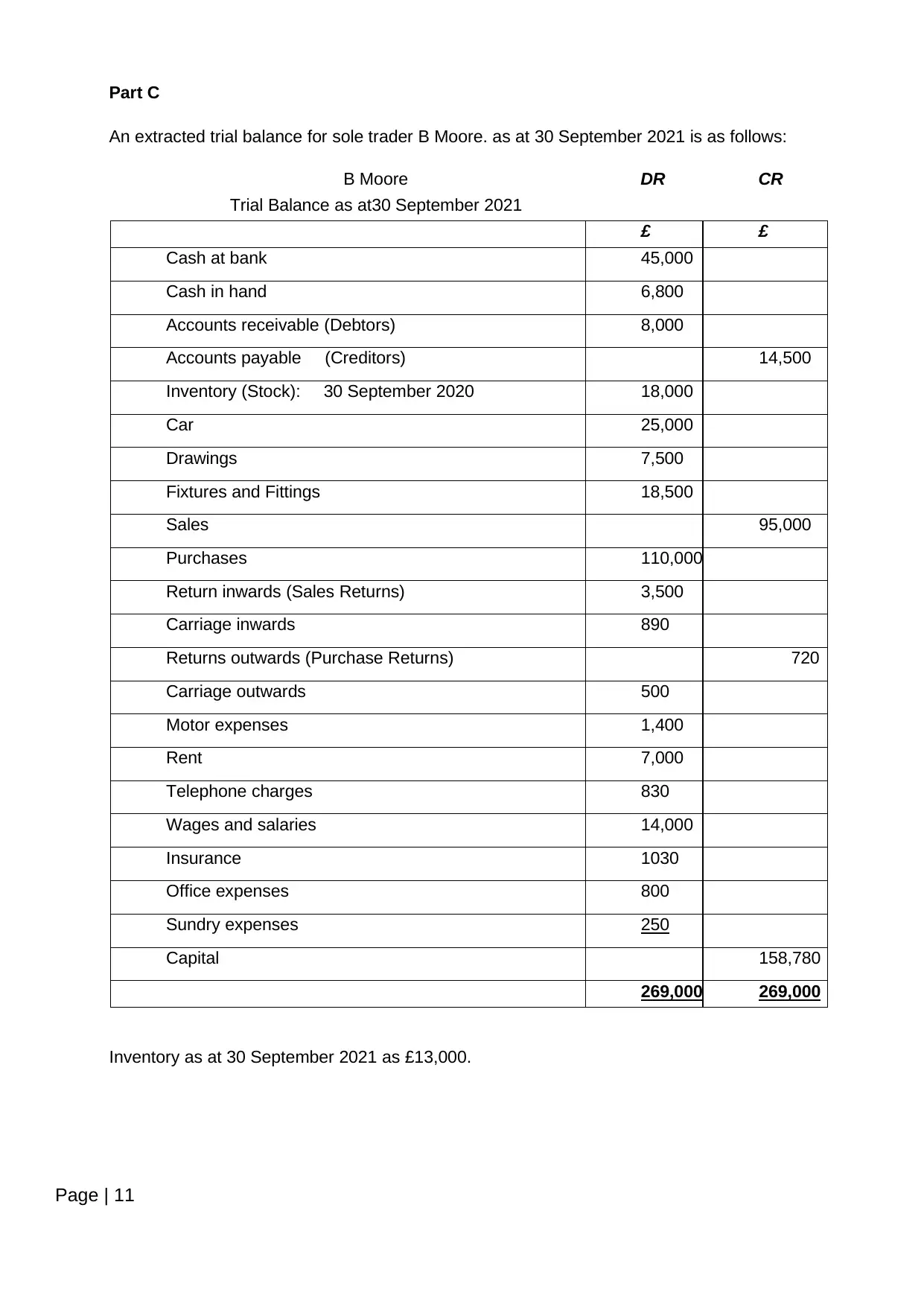
Page | 11
Part C
An extracted trial balance for sole trader B Moore. as at 30 September 2021 is as follows:
B Moore DR CR
Trial Balance as at30 September 2021
£ £
Cash at bank 45,000
Cash in hand 6,800
Accounts receivable (Debtors) 8,000
Accounts payable (Creditors) 14,500
Inventory (Stock): 30 September 2020 18,000
Car 25,000
Drawings 7,500
Fixtures and Fittings 18,500
Sales 95,000
Purchases 110,000
Return inwards (Sales Returns) 3,500
Carriage inwards 890
Returns outwards (Purchase Returns) 720
Carriage outwards 500
Motor expenses 1,400
Rent 7,000
Telephone charges 830
Wages and salaries 14,000
Insurance 1030
Office expenses 800
Sundry expenses 250
Capital 158,780
269,000 269,000
Inventory as at 30 September 2021 as £13,000.
Part C
An extracted trial balance for sole trader B Moore. as at 30 September 2021 is as follows:
B Moore DR CR
Trial Balance as at30 September 2021
£ £
Cash at bank 45,000
Cash in hand 6,800
Accounts receivable (Debtors) 8,000
Accounts payable (Creditors) 14,500
Inventory (Stock): 30 September 2020 18,000
Car 25,000
Drawings 7,500
Fixtures and Fittings 18,500
Sales 95,000
Purchases 110,000
Return inwards (Sales Returns) 3,500
Carriage inwards 890
Returns outwards (Purchase Returns) 720
Carriage outwards 500
Motor expenses 1,400
Rent 7,000
Telephone charges 830
Wages and salaries 14,000
Insurance 1030
Office expenses 800
Sundry expenses 250
Capital 158,780
269,000 269,000
Inventory as at 30 September 2021 as £13,000.
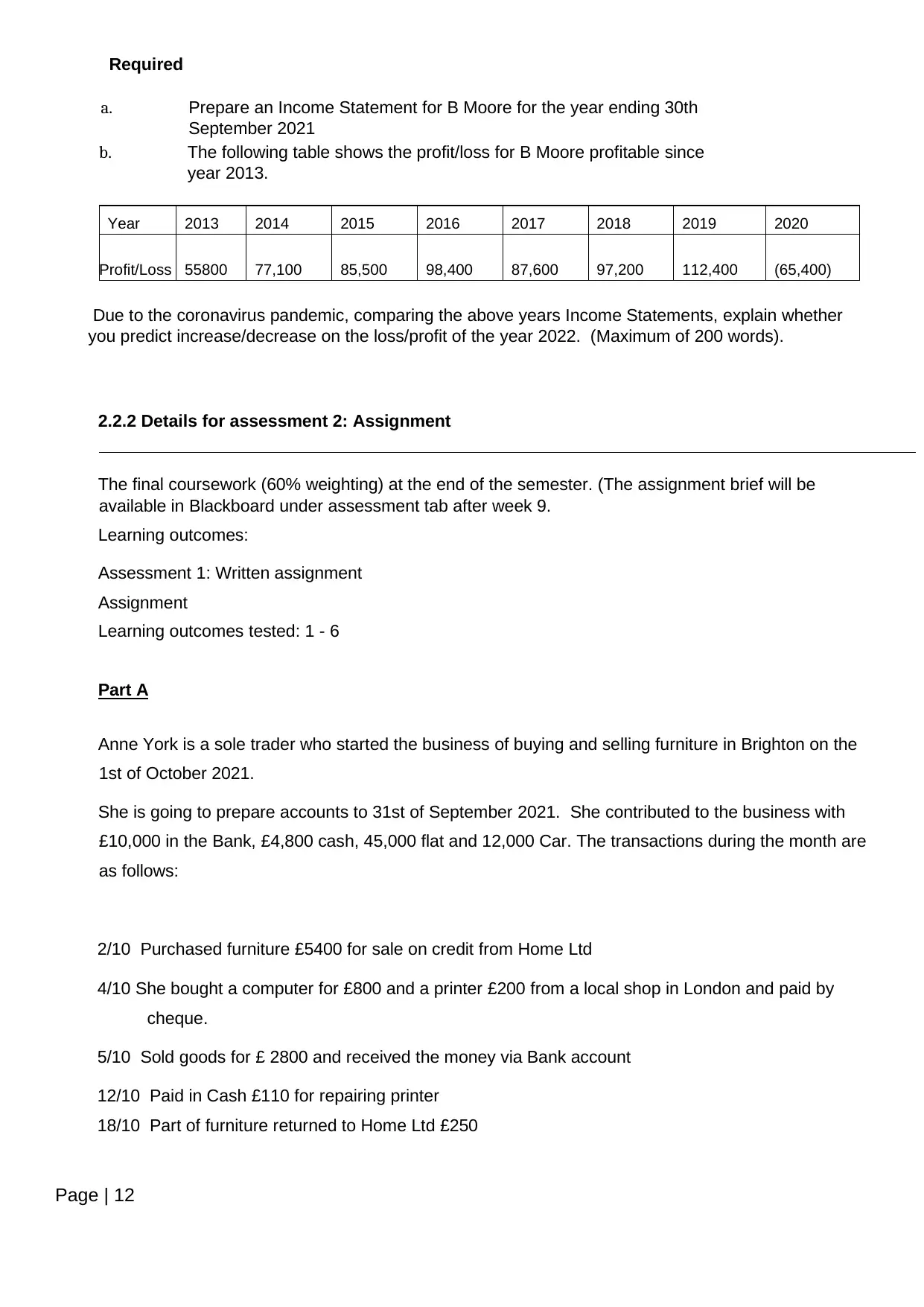
Page | 12
Required
a. Prepare an Income Statement for B Moore for the year ending 30th
September 2021
b. The following table shows the profit/loss for B Moore profitable since
year 2013.
Year 2013 2014 2015 2016 2017 2018 2019 2020
Profit/Loss 55800 77,100 85,500 98,400 87,600 97,200 112,400 (65,400)
Due to the coronavirus pandemic, comparing the above years Income Statements, explain whether
you predict increase/decrease on the loss/profit of the year 2022. (Maximum of 200 words).
2.2.2 Details for assessment 2: Assignment
The final coursework (60% weighting) at the end of the semester. (The assignment brief will be
available in Blackboard under assessment tab after week 9.
Learning outcomes:
Assessment 1: Written assignment
Assignment
Learning outcomes tested: 1 - 6
Part A
Anne York is a sole trader who started the business of buying and selling furniture in Brighton on the
1st of October 2021.
She is going to prepare accounts to 31st of September 2021. She contributed to the business with
£10,000 in the Bank, £4,800 cash, 45,000 flat and 12,000 Car. The transactions during the month are
as follows:
2/10 Purchased furniture £5400 for sale on credit from Home Ltd
4/10 She bought a computer for £800 and a printer £200 from a local shop in London and paid by
cheque.
5/10 Sold goods for £ 2800 and received the money via Bank account
12/10 Paid in Cash £110 for repairing printer
18/10 Part of furniture returned to Home Ltd £250
Required
a. Prepare an Income Statement for B Moore for the year ending 30th
September 2021
b. The following table shows the profit/loss for B Moore profitable since
year 2013.
Year 2013 2014 2015 2016 2017 2018 2019 2020
Profit/Loss 55800 77,100 85,500 98,400 87,600 97,200 112,400 (65,400)
Due to the coronavirus pandemic, comparing the above years Income Statements, explain whether
you predict increase/decrease on the loss/profit of the year 2022. (Maximum of 200 words).
2.2.2 Details for assessment 2: Assignment
The final coursework (60% weighting) at the end of the semester. (The assignment brief will be
available in Blackboard under assessment tab after week 9.
Learning outcomes:
Assessment 1: Written assignment
Assignment
Learning outcomes tested: 1 - 6
Part A
Anne York is a sole trader who started the business of buying and selling furniture in Brighton on the
1st of October 2021.
She is going to prepare accounts to 31st of September 2021. She contributed to the business with
£10,000 in the Bank, £4,800 cash, 45,000 flat and 12,000 Car. The transactions during the month are
as follows:
2/10 Purchased furniture £5400 for sale on credit from Home Ltd
4/10 She bought a computer for £800 and a printer £200 from a local shop in London and paid by
cheque.
5/10 Sold goods for £ 2800 and received the money via Bank account
12/10 Paid in Cash £110 for repairing printer
18/10 Part of furniture returned to Home Ltd £250
⊘ This is a preview!⊘
Do you want full access?
Subscribe today to unlock all pages.

Trusted by 1+ million students worldwide
1 out of 18
Related Documents
Your All-in-One AI-Powered Toolkit for Academic Success.
+13062052269
info@desklib.com
Available 24*7 on WhatsApp / Email
![[object Object]](/_next/static/media/star-bottom.7253800d.svg)
Unlock your academic potential
Copyright © 2020–2025 A2Z Services. All Rights Reserved. Developed and managed by ZUCOL.





